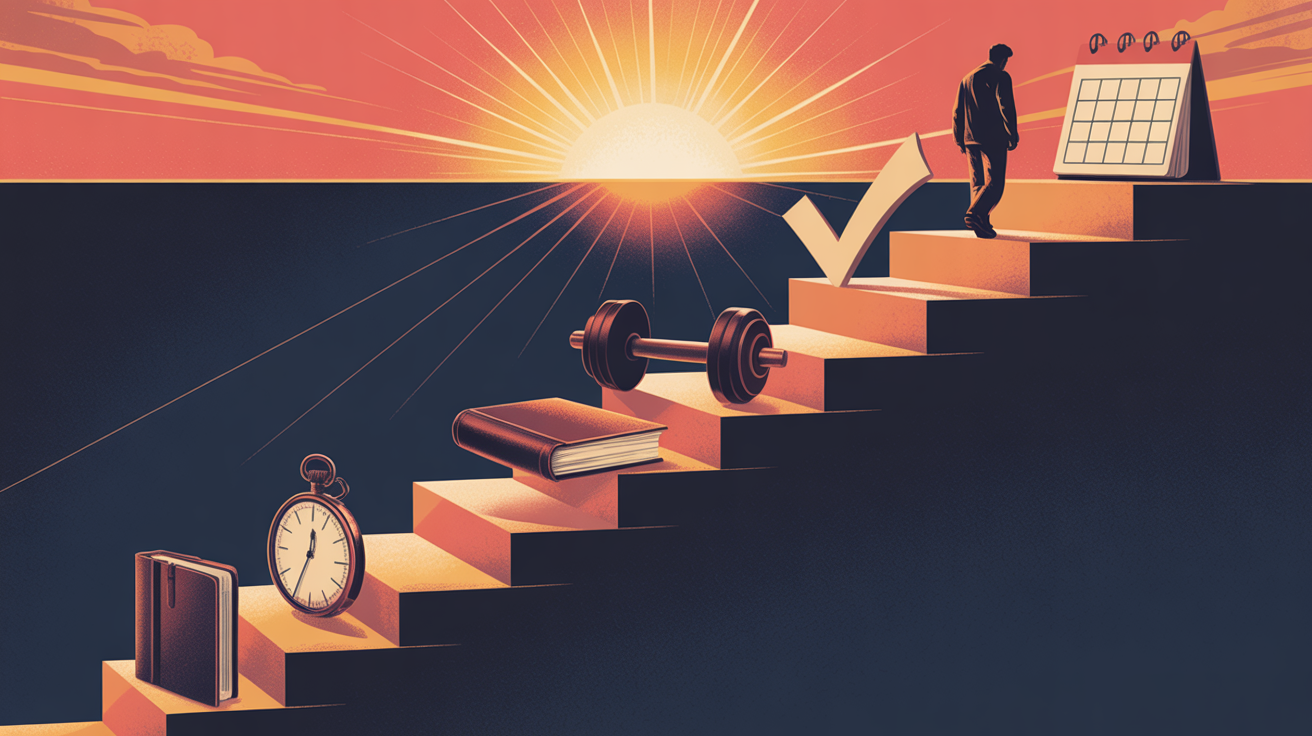
Best Tools to Build Self-Discipline That Actually Work
Self-discipline feels impossible when you’re scrolling social media instead of working on your goals. You know what you should be doing, but somehow your brain has other plans. The good news? Building self-discipline isn’t about having superhuman willpower. It’s about using the right tools to make good choices easier.
Self-discipline is the bridge between goals and accomplishment. Whether you want to eat healthier, exercise regularly, or focus better at work, the tools in this guide will help you build the mental strength to follow through on your intentions.
Let’s explore the most effective tools and strategies that can transform your self-control from wishful thinking into daily reality.
Understanding Self-Discipline Before We Dive Into Tools
Self-discipline isn’t a personality trait you’re born with or without. It’s a skill you can develop using specific techniques and tools. Think of it like a muscle that gets stronger with the right training.
Research shows that people with strong self-discipline are happier, healthier, and more successful. They have better relationships, less stress, and achieve their goals more consistently. The difference isn’t that they have more willpower than you. They’ve simply learned to structure their environment and use tools that make success more likely.
The key insight: Instead of relying on motivation alone, successful people create systems that work even when they don’t feel like it.
Digital Tools That Strengthen Your Self-Discipline
Habit Tracking Apps
Habit tracking apps turn abstract goals into concrete daily actions. They provide visual feedback that keeps you motivated and accountable.
Top habit tracking tools:
Habitica gamifies your habits by turning them into a role-playing game. You earn points and rewards for completing tasks, making self-discipline feel more like playing a game than forcing yourself through boring routines.
Streaks focuses on maintaining consecutive days of good habits. The visual chain of completed days becomes motivating in itself. You don’t want to break the chain.
Way of Life uses simple color coding to track multiple habits simultaneously. Green for good habits, red for bad ones. The visual feedback helps you see patterns in your behavior over time.
Forest helps you focus by planting virtual trees that grow when you stay off your phone. If you leave the app to check social media, your tree dies. The visual metaphor makes the cost of distraction tangible.
Time Management Applications
Time blocking apps help you allocate specific time slots to important activities, reducing the mental energy needed to decide what to do next.
Toggl Track shows you exactly where your time goes. Many people think they’re focused when they’re actually distracted for hours each day. Seeing the data helps you make better choices.
RescueTime runs in the background, automatically tracking how you spend time on your devices. It generates reports showing your most productive hours and biggest time wasters.
Focus blocks distracting websites and applications during work sessions. Instead of relying on willpower to avoid social media, you remove the option entirely.
Meditation and Mindfulness Tools
Mindfulness strengthens the mental muscles needed for self-discipline. These apps make meditation accessible even for complete beginners.
Headspace offers guided meditations specifically designed to improve focus and self-control. The sessions are short enough to fit into busy schedules but powerful enough to create real change.
Calm provides meditation programs that help you develop awareness of your thoughts and impulses. This awareness is the foundation of better self-discipline.
Insight Timer connects you with a global community of meditators while offering thousands of free guided sessions. The social element adds accountability to your practice.
Physical Tools and Environmental Design
Creating a Discipline-Friendly Environment
Your environment shapes your behavior more than you realize. Small changes to your physical space can dramatically improve your self-discipline without requiring more willpower.
Remove temptations from easy reach. If you’re trying to eat healthier, don’t keep junk food in the house. If you want to read more, put books where you can see them and hide the TV remote.
Make good choices easier by preparing in advance. Lay out workout clothes the night before. Prep healthy meals on Sunday. The less friction between you and good habits, the more likely you’ll follow through.
Visual cues remind you of your goals when motivation is low. A photo of your ideal body on the fridge. A vision board in your bedroom. A sticky note on your computer screen.
Analog Tools That Work
Physical planners engage different parts of your brain than digital tools. The act of writing by hand improves memory and commitment to your plans.
The Pomodoro Technique uses a simple timer to break work into focused 25-minute sessions. The physical timer creates urgency and helps you push through resistance.
Accountability journals help you track progress and reflect on what’s working. Writing about your challenges helps you spot patterns and adjust your approach.
Vision boards make abstract goals concrete through visual representation. Creating one forces you to clarify exactly what you want and why it matters.
Mental Tools and Psychological Strategies
The Power of Implementation Intentions
Implementation intentions are specific plans that connect situational cues to desired behaviors. Instead of saying “I will exercise more,” you say “When I wake up at 6 AM, I will immediately put on my workout clothes and go for a run.”
This simple shift doubles your chances of following through because it removes the need to make decisions in the moment. Your brain already knows what to do.
Examples of effective implementation intentions:
- “When I finish lunch, I will immediately start my most important work task.”
- “When I feel the urge to check social media, I will take three deep breaths instead.”
- “When I get home from work, I will change into workout clothes before sitting down.”
Mental Contrasting Technique
Mental contrasting involves imagining your desired outcome, then identifying the obstacles that might prevent you from achieving it. This creates a realistic plan rather than wishful thinking.
The process works in four steps:
- Wish: Clearly define what you want to achieve
- Outcome: Visualize the benefits of achieving it
- Obstacle: Identify what might get in your way
- Plan: Create specific strategies to overcome obstacles
This technique helps you prepare for challenges instead of being surprised by them.
The Two-Minute Rule
If something takes less than two minutes, do it immediately. This prevents small tasks from accumulating into overwhelming piles that require massive self-discipline to tackle.
The rule also works in reverse for building habits. Make the first step of any new habit take less than two minutes. Want to read more? Start by reading one page. Want to exercise? Start by putting on workout shoes.
Small actions build momentum and confidence, making it easier to continue.
Social Tools and Accountability Systems
Building Your Support Network
Social accountability dramatically improves your chances of sticking to goals. When others know about your commitments, you’re more likely to follow through.
Accountability partners check in with you regularly about your progress. Choose someone who will be honest about whether you’re making excuses or real progress.
Online communities connect you with others working toward similar goals. The motivation comes from seeing others succeed and not wanting to let the group down.
Public commitments use social pressure to your advantage. Share your goals on social media or tell friends and family what you’re working on.
Professional Support Options
Coaches provide expertise and external accountability that’s hard to maintain on your own. They help you spot blind spots and adjust strategies when you’re stuck.
Therapists can help address underlying issues that make self-discipline difficult, such as anxiety, depression, or past trauma.
Support groups connect you with others facing similar challenges. Sometimes knowing you’re not alone is enough to keep going.
Biological Tools for Better Self-Control
Optimizing Your Physical Foundation
Sleep quality directly impacts your self-discipline. When you’re tired, the prefrontal cortex that controls impulses doesn’t function properly. Prioritizing 7-9 hours of quality sleep is one of the most effective tools for better self-control.
Regular exercise improves your brain’s ability to focus and resist temptations. Even a 10-minute walk can boost your willpower for several hours afterward.
Proper nutrition keeps your blood sugar stable, preventing the decision fatigue that leads to poor choices. Eating protein and complex carbohydrates helps maintain steady energy throughout the day.
Hydration affects cognitive function more than most people realize. Dehydration makes it harder to concentrate and easier to give in to impulses.
Timing Your Decisions
Decision fatigue is real. Your self-discipline is strongest in the morning and gradually depletes throughout the day. Use this knowledge strategically.
Schedule your most important tasks and decisions for when your willpower is strongest. Save routine or easy tasks for later in the day when your mental energy is lower.
Batch similar decisions to reduce the total number of choices you need to make. Steve Jobs wore the same outfit every day for this reason. The less you need to decide, the more energy you have for what matters.
Advanced Strategies for Long-Term Success
The 1% Better Principle
Small improvements compound over time into dramatic results. Instead of trying to transform your entire life overnight, focus on getting 1% better each day.
This approach works because it doesn’t trigger the psychological resistance that comes with big changes. Your brain accepts small improvements more easily than radical shifts.
Examples of 1% improvements:
- Drinking one extra glass of water daily
- Reading five more minutes each day
- Doing one extra push-up each workout
- Saving an additional dollar every day
Celebrating Small Wins
Recognition reinforces behavior. Your brain needs feedback to know which actions to repeat. Celebrating small victories trains your brain to associate self-discipline with positive feelings.
The celebration doesn’t need to be elaborate. A simple “Yes!” or mental high-five is enough to strengthen the neural pathways associated with good choices.
Keep a success journal where you write down three things you did well each day. This trains your brain to notice and appreciate progress instead of focusing only on what went wrong.
Creating Rituals and Routines
Routines reduce the mental energy needed to make good choices. When behaviors become automatic, they require less willpower to maintain.
Morning routines set a positive tone for the entire day. Evening routines help you wind down and prepare for tomorrow’s success.
Effective routine elements:
- Consistent wake and sleep times
- Regular meal schedules
- Designated work and exercise times
- Weekly planning sessions
- Daily reflection practices
Troubleshooting Common Self-Discipline Challenges
When Motivation Disappears
Motivation is unreliable. It comes and goes based on mood, circumstances, and energy levels. Building systems that work without motivation is essential for long-term success.
Focus on making good choices easier rather than trying to summon more willpower. Change your environment, use implementation intentions, and rely on habits rather than daily decisions.
Dealing with Perfectionism
Perfectionism kills progress. The all-or-nothing mindset leads to giving up entirely when you make mistakes.
Instead, adopt a “progress, not perfection” approach. Every small step forward counts, even if it’s not perfect. Getting back on track quickly after mistakes is more important than never making mistakes at all.
Overcoming Analysis Paralysis
Too many options can paralyze decision-making. When you’re overwhelmed by choices, you end up making no choice at all.
Start with one or two tools from this guide rather than trying to implement everything at once. Master the basics before adding complexity.
Building Your Personal Self-Discipline Toolkit
Start small and build gradually. Choose one digital tool, one environmental change, and one mental strategy to begin with. Give yourself at least two weeks to establish these practices before adding more.
Experiment to find what works for you. Different tools work for different people and different goals. Pay attention to which strategies feel natural and which require too much effort to maintain.
Review and adjust regularly. Your needs will change as you develop stronger self-discipline. What works in the beginning might need modification as you progress.
Remember that setbacks are normal. Everyone struggles with self-discipline sometimes. The key is getting back on track quickly rather than giving up entirely.
Self-discipline isn’t about perfection or superhuman willpower. It’s about using smart tools and strategies that make good choices easier and bad choices harder. The tools in this guide have helped millions of people build the self-control they need to achieve their goals.
Your future self is counting on the choices you make today. Start with one tool, take one small step, and begin building the disciplined life you want. The best time to start was yesterday. The second best time is right now.
The journey to stronger self-discipline begins with a single decision to take action. Which tool will you try first?






